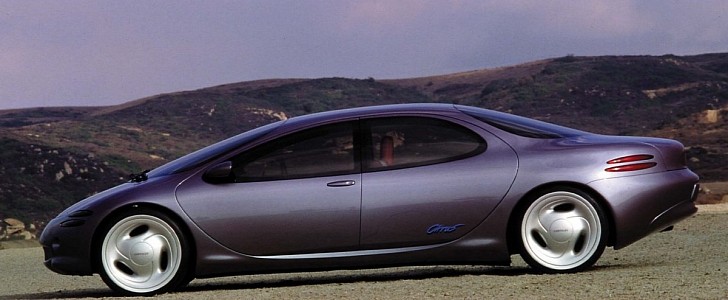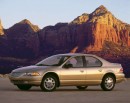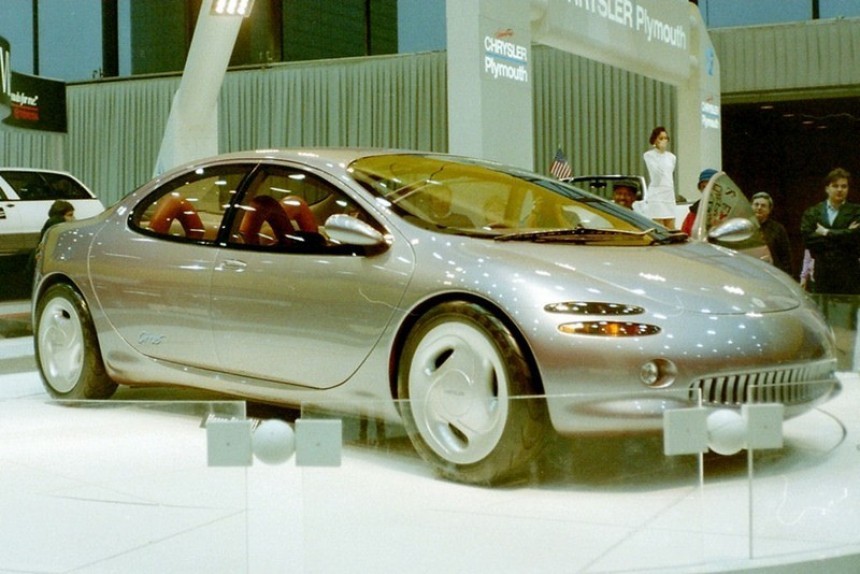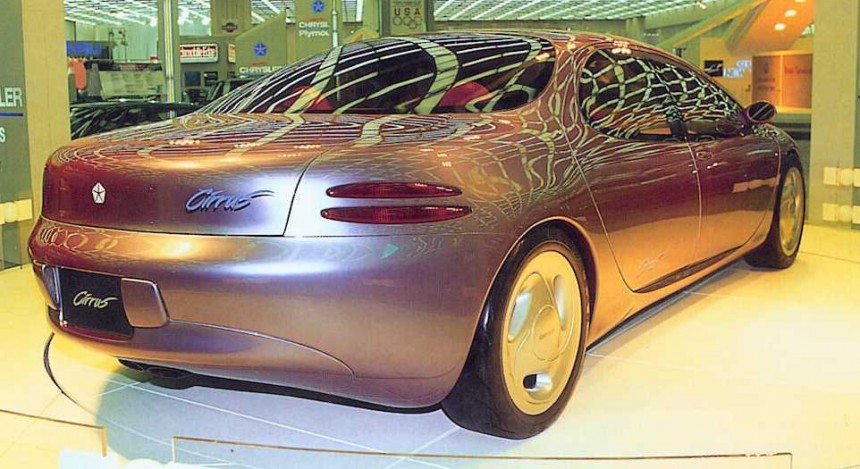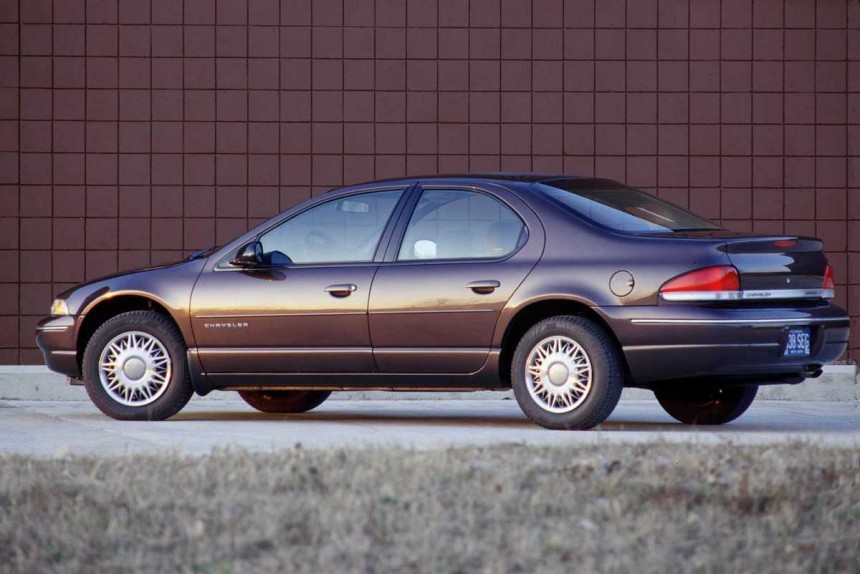Chrysler had quite a few dreamers in its design office and managed to pull some astonishing concept cars at the beginning of the '90s, and the Cirrus was one of them, which pointed toward the cab-forward concept evolution. Yet, the result was embarrassing.
Chrysler had to switch to front-wheel-drive vehicles to survive the market trends. The European and Japanese carmakers had cornered the U.S. carmaker and forced it to upgrade. Chrysler came with the cab-forward design theme, which led to an increased interior room for all passengers. Then, there was another idea: how about making the ingress and egress easier for all occupants?
In the Concept 2 Reality journey, I didn't want to miss the Cirrus. A car that promissed a lot to many, but delivered less to just a few. The design department had started to look back at other models from Chrysler's history and imagined the Cirrus. A car that should have made its occupants feel pampered. It was a daring concept unveiled in 1992, but not as bold as the 1989 Viper. From many points of view, it was an ideal family sedan.
Unlike the Chrysler Imperial or the New Yorker, the Cirrus didn't have sharp edges or flat panels. Its bio-design shape was inspired by wind and open spaces. At the front there was a new concept for the headlights, which peaked through a pair of openings above the turn-signal lamps. An arched greenhouse with a very sloped rear window created enough interior room for four adult-sized occupants. Maybe the rear end of the vehicle was not the best-inspired part of the car.
Through the rear-hinged rear doors the occupants could easily enter the vehicle. Since there was no B-pillar, it was like getting inside a big, airy room. But the performance-oriented vehicle offered bucket seats for four occupants.
Chrysler promised a 400 hp powerplant for the Cirrus. Just remember that in those times, that was more than what BMW M5 offered. But the American carmaker obtained that power from an intriguing engine: a 3.0-liter, turbocharged, two-stroke V6.
The production model that wore the Cirrus nameplate came on the market in 1994 and was nothing like the concept car. We understand that Chrysler couldn't make suicide doors for the rear passengers, but it was more than that. While the 1992 prototype promised a bold design, the production model was rather modest, not revolutionary at all.
Chrysler used the Cirrus to replace the LeBaron lineup. Its bodywork was made out of curved lines and panels. Its waterfall-type grille was narrow and short between the headlights. The overall shape was far more pleasant than the wedged ones from its predecessor and conquered many buyers right from the start. It was available exclusively with an automatic transmission. Yet, there was no 400 hp powerplant under the hood.
But the Cirrus was just one of the three siblings. The Plymouth Breeze and the Dodge Stratus followed in 1995 and in 1996, respectively. The three vehicles, named "cloud-cars," offered something for every budget, and the Cirrus was the most upscale version. These names came from meteorology, representing types of clouds, and the Cirrus was on top of them.
The mid-size sedan had two engine options: a 2.4-liter inline-four and a 2.5-liter V6 carried over from Mitsubishi. Its four-speed automatic gearbox was not the best in class but still offered enough comfort and fuel efficiency. The cabin was adequate even for larger-sized people, and the trunk was roomier than on its main competitors, with 445 liters (15.7 cu-ft) of volume.
Another important improvement was the independent suspension on all corners, with a double-wishbone at the front and a multi-link system in the rear. That setup transformed the car into a comfortable ride but it was also good at handling. As a result, it sold well and was well-received by the market, despite being far from the concept car's shape.
Even though Chrysler didn't fulfill its promise to offer a far more advanced vehicle on the market, customers were happy with the Cirrus. Yet, in just a few years, the car's sales lost their steam and the Cirrus became less and less desirable. Not even the alloy wheels and the keyless-entry system couldn't bring back the buyers. Eventually, in 2000, Chrysler axed the model from the assembly lines. Before axing it, it killed the Plymouth Breeze as well.
The Cirrus was a half-fulfilled promise. Chrysler didn't have the courage to be more daring with the production version, especially since it didn't have a proper engine to place under the hood. Maybe that's why the car lived for only five years.
Some will say that the Daimler part of the DaimlerChrysler alliance killed it. Actually, they didn't. They even tried to sell it in Europe with the 2.0-liter engine, which was too weak compared to its direct competitors.
In the Concept 2 Reality journey, I didn't want to miss the Cirrus. A car that promissed a lot to many, but delivered less to just a few. The design department had started to look back at other models from Chrysler's history and imagined the Cirrus. A car that should have made its occupants feel pampered. It was a daring concept unveiled in 1992, but not as bold as the 1989 Viper. From many points of view, it was an ideal family sedan.
Unlike the Chrysler Imperial or the New Yorker, the Cirrus didn't have sharp edges or flat panels. Its bio-design shape was inspired by wind and open spaces. At the front there was a new concept for the headlights, which peaked through a pair of openings above the turn-signal lamps. An arched greenhouse with a very sloped rear window created enough interior room for four adult-sized occupants. Maybe the rear end of the vehicle was not the best-inspired part of the car.
Through the rear-hinged rear doors the occupants could easily enter the vehicle. Since there was no B-pillar, it was like getting inside a big, airy room. But the performance-oriented vehicle offered bucket seats for four occupants.
The production model that wore the Cirrus nameplate came on the market in 1994 and was nothing like the concept car. We understand that Chrysler couldn't make suicide doors for the rear passengers, but it was more than that. While the 1992 prototype promised a bold design, the production model was rather modest, not revolutionary at all.
Chrysler used the Cirrus to replace the LeBaron lineup. Its bodywork was made out of curved lines and panels. Its waterfall-type grille was narrow and short between the headlights. The overall shape was far more pleasant than the wedged ones from its predecessor and conquered many buyers right from the start. It was available exclusively with an automatic transmission. Yet, there was no 400 hp powerplant under the hood.
But the Cirrus was just one of the three siblings. The Plymouth Breeze and the Dodge Stratus followed in 1995 and in 1996, respectively. The three vehicles, named "cloud-cars," offered something for every budget, and the Cirrus was the most upscale version. These names came from meteorology, representing types of clouds, and the Cirrus was on top of them.
Another important improvement was the independent suspension on all corners, with a double-wishbone at the front and a multi-link system in the rear. That setup transformed the car into a comfortable ride but it was also good at handling. As a result, it sold well and was well-received by the market, despite being far from the concept car's shape.
Even though Chrysler didn't fulfill its promise to offer a far more advanced vehicle on the market, customers were happy with the Cirrus. Yet, in just a few years, the car's sales lost their steam and the Cirrus became less and less desirable. Not even the alloy wheels and the keyless-entry system couldn't bring back the buyers. Eventually, in 2000, Chrysler axed the model from the assembly lines. Before axing it, it killed the Plymouth Breeze as well.
Some will say that the Daimler part of the DaimlerChrysler alliance killed it. Actually, they didn't. They even tried to sell it in Europe with the 2.0-liter engine, which was too weak compared to its direct competitors.
